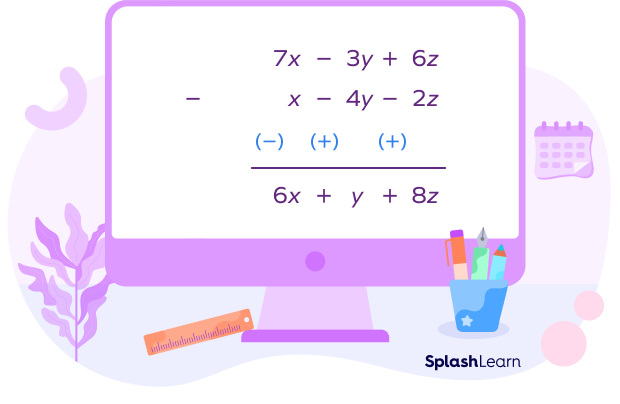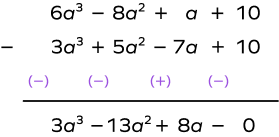What Is Subtracting Polynomials?
Subtracting polynomials follows a similar procedure as adding polynomials. We just have to deal with the minus sign $(\;-\;)$ in between.
Consider the expression p$(x)\;-\;q(x)$ representing the subtraction of polynomials. Here, we are subtracting q(x) from p(x). Due to the minus sign before q(x), the signs of all the terms in the polynomial q(x) are changed (“$+$ changes to $-$” and “$-$ changes to $+$”). Next, we simplify by combining the like terms and find the answer.
In simple words, when subtracting polynomials, we reverse the signs of each term in the second polynomial and then add the polynomials as usual.
Let us see how to subtract polynomials.
Recommended Games
Methods of Subtracting Polynomials
There are two ways to subtract polynomials:
- Subtracting polynomials horizontally
- Subtracting polynomials vertically
Regardless of which method of subtracting polynomials we use, the idea and the procedure is the same. The only difference is the arrangement or placement of polynomials during the subtraction operation.
Recommended Worksheets
Horizontal Method of Subtracting Polynomials
Take a look at the steps required for the horizontal method of subtracting polynomials with an example.
Example: Subtract $P = 2x^{3} \;-\; 3y^{2} + 3z$ from $Q = 7y^{2} + 5x^{3} \;–\; 2z$.
Here, $P = 2x^{3} \;-\; 3y^{2} + 3z$ and $Q = 7y^{2} + 5x^{3} \;–\; 2z$
We have to find Q – P.
Step 1: Arrange the two polynomials in the standard forms.
$Q = 7y^{2} + 5x^{3} \;–\; 2z = 5x^{3} + 7y^{2} \;-\; 2z$
$P = 2x^{3} \;-\; 3y^{2} + 3z$ is already in the standard form.
Step 2: Place them horizontally separated by minus sign (–) such that the second polynomial is in the parentheses.
$Q \;-\; P = (5x^{3} + 7y^{2} \;-\; 2z) \;–\; (2x^{3} \;-\; 3y^{2} + 3z)$
Step 3: Remove the parentheses. For the second polynomial, change the sign of each term after removing the parentheses.
$Q \;-\; P = 5x^{3} + 7y^{2} \;-\; 2z \;–\; (2x^{3} \;-\; 3y^{2} + 3z)$
$Q \;-\; P = 7y^{2} + 5x^{3} \;–\; 2z \;–\; 2x^{3} + 3y^{2} \;-\; 3z$
Step 4: Arrange all like terms together and solve.
$Q \;-\; P = 5x^{3} \;-\; 2x^{3} + 7y^{2} + 3y^{2} \;-\; 2z \;-\;3z$
$Q \;-\; P = 3x^{3} + 10y^{2} \;-\; 5z$
Vertical Method of Subtracting Polynomials
In the vertical method, all the equations are arranged in columns according to the like terms. The signs are changed and the operation takes place.
Take a look at the example of a vertical method of subtracting polynomials given below:
Find: $(7x \;–\; 3y + 6z) \;-\; x \;–\; 4y \;–\; 2z$ using the vertical method.
Step 1: Arrange the two polynomials in the standard form.
Here, both polynomials are already in the standard form.
Step 2: Arrange the expressions one below the other such that the polynomial being subtracted is at the bottom. Align the like terms. There will be two rows, in which the lower row is subtracted from the upper row.

Step 3: Change the signs of all the terms of the second row; positive changes to negative and negative sign changes to positive. Finally, add the like terms.

Facts on Subtracting Polynomials
- Subtracting polynomials is the same as adding the opposite.
For example, 3-5 and 3 + (-5) represent the same thing. Similarly,
$(7x \;-\; 5y) \;-\; (3x + 2y)$ and $(7x \;-\; 5y) + (\;-\; 3x \;-\; 2y)$ are the same. - When subtracting polynomials, it is important to distribute the subtraction sign to each term of the polynomial being subtracted. This means changing the sign of each term before combining like terms.
- In algebra, the like terms are terms having the same variable raised to the same power. In other words, their variable part is the same such that the same variables have the same exponent powers.
Conclusion
In this article, we learned to subtract polynomial expressions, different methods to subtract polynomials, facts and examples. Now, let us practice solving problems by subtracting polynomials.
Solved Examples of Subtracting Polynomials
1. Subtract $2x \;-\; 5y + 3z$ from $5x + 9y \;-\; 2z$ using the horizontal method.
Solution:
We have to find $(5x + 9y \;–\; 2z) \;-\; (2x \;-\; 5y + 3z)$.
Remove the parentheses by multiply the negative sign with the terms
$= 5x + 9y \;-\; 2z \;–\; 2x + 5y \;-\; 3z$
Arrange the like terms together.
$= 5x \;–\; 2x + 9y + 5y \;-\; 2z \;-\; 3z$
$= 3x + 14y \;-\; 5z$
2. Subtract $4x \;-\; 10y +15z$ from $5x + 8y \;-\; 20z$ using the horizontal method.
Solution:
$(4x \;-\; 10y + 15z) \;-\; (5x + 8y \;-\; 20z)$
Sign change of the second polynomial by removing the parentheses and multiplying
$= 4x \;-\; 10y + 15z \;-\; 5x \;-\; 8y + 20z$
Combine the like terms.
$= 4x \;-\; 5x \;-\; 10y \;-\; 8y + 15z + 20z$
$= \;-\; x \;-\; 18y + 35z$
3. Subtract $5x \;–\; 3y \;–\; 4z$ from $7x \;–\; 6y + 6z$ using the vertical method.
Solution:
We have to find $7x \;-\; 6y + 6z \;-\; (5x \;–\; 3y \;–\; 4z)$.
Arrange the expression in two rows with like terms in the same column. Change the sign of each term of the second row and proceed with the operation.

4. Subtract $3a^{3} + 5a^{2} \;–\; 7a + 10$ from $6a^{3} \;-\; 8a^{2} + a + 10$.
Solution:
$6a^{3} \;-\; 8a^{2} + a + 10 \;-\;(3a^{3} + 5a^{2} \;–\; 7a + 10)$
Arrange the expression in two rows with like terms in the same column. Change the sign of each term of the second row and proceed with the operation.

Thus,
$6a^{3} \;-\; 8a^{2} + a + 10 \;-\; (3a^{3} + 5a^{2} \;–\; 7a + 10)$
$= 3a^{3} \;-\; 13a^{2} + 8a \;-\; 0$
5. Subtract the polynomials horizontally $15x^{3} + 12y^{2} \;-\; 8z \;-\; 7$ from $20x^{3} \;-\; 6y^{2} + 31z + 9$.
Solution:
We have to find $20x^{3} \;-\; 6y^{2} + 31z + 9 \;-\; (15x^{3} + 12y^{2} \;-\; 8z \;-\; 7)$.
Sign change of the second polynomial through the parentheses
$= 20x^{3} \;-\; 6y^{2} + 31z + 9 \;-\; 15x^{3} \;-\; 12y^{2} + 8z + 7$
Combine the like terms.
$= 20x^{3} \;-\; 15x^{3} \;-\; 6y^{2} \;-\; 12y^{2} + 31z + 8z + 9 + 7$
$= 5x^{3} \;-\; 18y^{2} + 39z +16$
Practice Problems on Subtracting Polynomials
Subtracting Polynomials: Definition, Methods, Examples, Steps, FAQs
Solve: $(5x\;-\;2y + 1)\;-\;(2x\;-\;7y + 4)$.
$(5x\;-\;2y + 1)\;-\;(2x\;-\;7y + 4)$
$= 3x + 5y\;-\;3$
$(12p^{2} + 15p + 3)\;-\;(2p^{2} + 17p\;-\;2) =$
$(12p^{2} + 15p + 3)\;-\;(2p^{2} + 17p\;-\;2)$
$= 10p^{2}\;-\;2p + 5$
$(x + y)\;-\;(y\;-\;x)=$
$(x + y)\;-\;(y\;-\;x) = x + y\;-\;y + x = 2x$
Frequently Asked Questions about Subtracting Polynomials
What property is used when subtracting polynomials?
In the procedure of subtracting polynomials, the distributive property is used. This is also used while adding polynomials.
Example: $(3x^{2} + 2x + 6) + (x^{2} \;-\; 6x \;-\; 10)$
$= (3 + 1)x^{2} + (2 \;-\; 6)x + (6 \;-\; 10)$
$= 4x^{2} \;-\; 4x \;-\; 4$
What is the rule followed while subtracting polynomials?
There are two important rules to follow while subtracting polynomials. They are:
- Arrange the like terms together while performing subtraction.
Signs of each term of the subtracting polynomial should be changed. That is “$+$” changes to “$-$” and “$-$” changes to “$+$.”
How can subtracting polynomials be simplified?
Subtracting polynomials can be simplified by converting the problem from subtraction to addition. Change all the signs of the terms of the second polynomials through the parentheses, that is “$+$” changes to “$-$” and “-” changes to “$+$.” Once it is done, the normal addition of polynomials is performed.




































